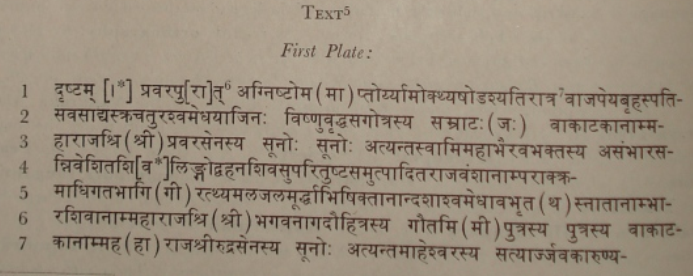|
INSCRIPTIONS OF THE MAIN BRANCH
...The record is dated, in line 28, on the tenth day of the fourth fortnight of the rainy season in the twenty-third year evidently of Pravarasēna II’s reign. It does not admit of
verification, but probably corresponds to the tenth tithi of the bright half of the month Bhādrapada. The date is noteworthy as it is one of the two season dates known so far from Vākāṭaka
inscriptions. In all other inscriptions dates are recorded in lunar months and tithis.
...The localities mentioned in the present grant have not yet been satisfactorily identified.
Dr. Kielhorn suggested the identification of Chandrapura with Chāndpur, ‘which lies to the
south of Siwanī and to the west of the Wengaṅgā river1’, but he could not locate the other
places mentioned in the grant. Dr. Hiralal proposed to identify Ārammi with Ārvī, the chief
town of the Ārvī tahsil of the Wardhā District, and Chandrapura with Chāndur where there
is a confluence of the two rivers Chandrabhāgā and Sarasvatī. Further, he suggested that Hiraṇyapura might be Sōnegaon near Chāndur and Karmakāra, Kalamgaon close to the
same town2. These identifications also are not quite satisfactory. A clue to location of the
places is possibly afforded by the mention of Hiraṇyapura. This town may have been
situated on the river Hiraṇyā which is mentioned in the Waḍgaon plates of Pravarasena II.
As shown elsewhere, this Hiraṇyā is identical with the modern river Earī3. Chandrapura
may be the modern Chāndā, the chief town of the Chāndā District. This old name of the
town is still current. Near Chāndā there is the confluence of the two rivers, Ēraī and
Jharpaṭ. In fact the town of Chāndā is situated in the angle formed by these two rivers,
so that its situation answers to the description of Chandrapura in the present grant viz.
that it was a saṅgamikā or ‘a tract of land near the confluence of two rivers’; but the mention
of Ārammi-rājya in the recently discovered Pāṇḍhurṇā plates4 also has raised doubts
about these identifications. Since both the grants which mention Ārammi-rājya come from
the Chhindwārā District, we must evidently look for the places situated in them in that
very district. As shown elsewhere, some of the localities referred to in the Pāṇḍhurṇā
plates can be identified in the neighbourhood of Pāṇḍhurṇā, which indicates that Ārammi,
the headquarters of that division, may be modern Āmlā, about 40 miles north by west
of Pāṇḍhurṇā. None of the places mentioned in the present grant can, however, be traced
in that region, unless Hiraṇyapura is Haraṇkheḍī, about 6 miles north of Multāi.

_______________________________
1 Ep. Ind., Vol. III, p. 260.
2 I.C.P.B., p. 93.
3 Below, p. 54.
4 No. 14, lines 26 and 29.
5 From the fasimiles facing pages 260 and 261 in Ep. Ind., Vol. III.
6 Here and in many places below, the rules of sandhi have not been observed.
7 Originally -तिरोत्र,changed to तिरात्र.
|